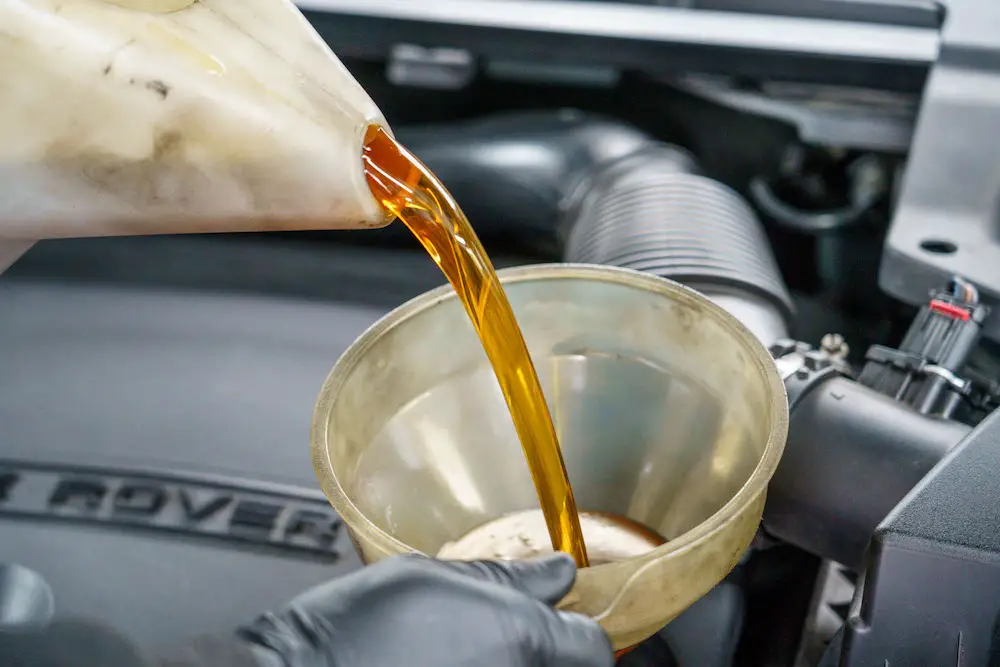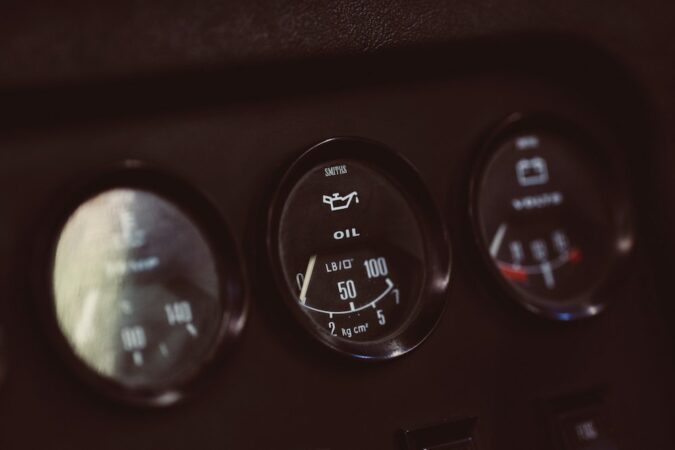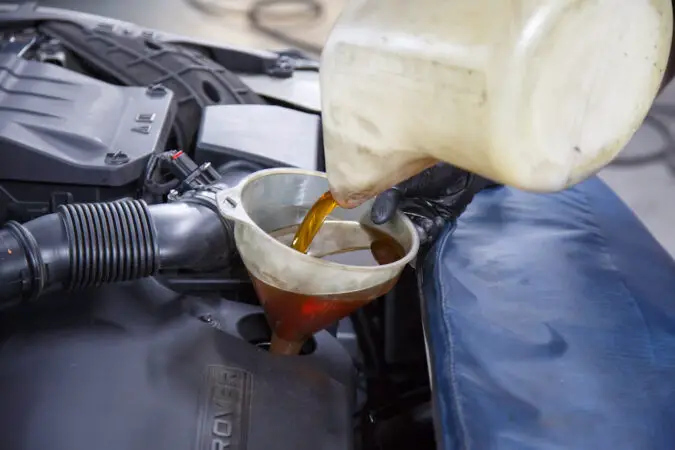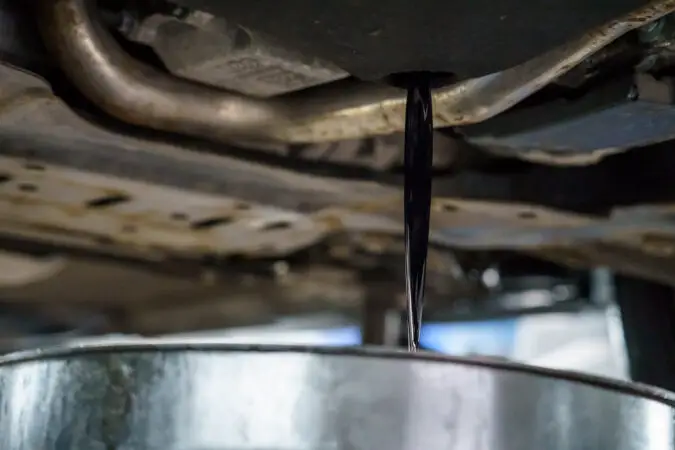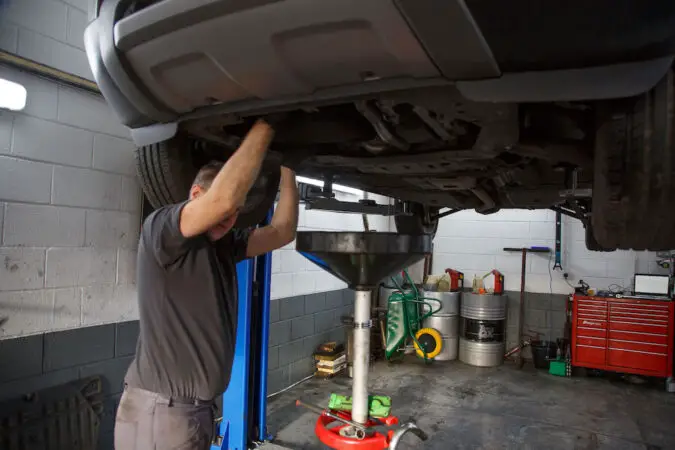Changing your car’s oil is one of the most basic and straightforward automotive activities that almost anybody can perform. Even so, anyone may make a mistake, and pouring too little or too much oil in car can both be disastrous.
If you add too much oil in car, it could have a number of serious effects if you don’t address it right away. Oil overfilling can manifest itself in a variety of ways, including the oil dipstick indicator level, blue exhaust smoke, leaking oil, and even an engine misfire.
Fortunately, if found early, the problem is not nearly as difficult to rectify, but if overfilling symptoms are disregarded, a new engine may be required in the worst-case situation. In this article, we’ll go over the symptoms of too much oil in the car and how to get rid of it.
- Purpose
- Indication
- How Much Oil Added
- Symptoms
- How To Resolve It?
- Is It Possible To Drive?
- Final Verdict
What Is The Necessity For Oil In Engines?
Engine oil serves a variety of purposes. The first step is to keep the engine parts thoroughly lubricated in order to avoid excessive friction. Friction can damage the motor’s internal components, causing it to wear out more quickly.
If you replace your oil on a regular basis, it will also keep your engine clean. The oil flows throughout the engine, carrying any dirt or filth to the oil filter, catching the waste, and preventing it from recycling back into the engine.
Oil also keeps your engine cool, preventing it from overheating. An engine that overheats will most likely shut down. Then you’ll have to replace it, which will be extremely expensive. Engines, like labor to install them, aren’t cheap.
What Happens If You Add Too Much Oil In Car?
For a vehicle with so many moving parts, oil is required. It’s crucial to utilize the right amount. Too little oil is a well-known cause of engine failure, while too much oil in car is a concern that is sometimes neglected. If there is too much oil in car, it can cause a variety of problems.
1. Too Much Oil In Car – Oil With Froth
Oil is added to a vehicle through the fill tube and into the oil pan, which is a reservoir. If the pan is overfilled, it will “overflow,” allowing oil to reach moving engine components it was not intended to contact.
Despite the fact that it is circulated through the engine to lubricate its components, oil that comes into touch with the crankshaft can be churned up like milk in a frothing machine.
Due to the aeration process, this could have the opposite effect of its original function and not lubricate needed portions. Oil loses its lubricity and, consequently, its effectiveness due to this foaming.
2. Too Much Oil In Car – Excessive Stress
An engine and its moving parts are sealed to prevent things like water from entering and interfering with balancing or causing further damage. As a result, there is a lot of pressure in a lot of places inside the engine.
Similarly, the systems that deliver oil to required parts are pressured. Increases in component and overall engine pressures can be caused by increased oil volume. This may not be a concern in the short term, but it will undoubtedly cause problems if left unaddressed.
3. Too Much Oil In Car – Oil Leakage
Oil leaks are one of the immediate consequences of increased engine pressure. An engine is made up of thousands of components that are sealed by gaskets and bolts, rather than being one large piece that contains all of the working parts.
Increased engine pressure can push the gaskets past their breaking point, causing them to leak or explode slowly. The consequences could range from a small puddle of oil on the garage floor to a huge pool of oil all over the engine.
4. Too Much Oil In Car – Problems With Spark Plugs
Spark plug problems are usually caused by two factors: aging or fouling. Spark plug fouling is frequently caused by extra gasoline or oil that isn’t completely consumed during the engine’s combustion process.
As a result, spark plug problems caused by too much oil in car are typically the result of long-term oil leaks and failure to address excess oil concerns. Spark plug problems can cause significant difficulties on their own, making this an even more serious concern than leaking.
Spark plug fouling can cause fuel mileage to decrease, engine misfiring, and even the engine to totally stop while driving, in addition to being inconvenient and sometimes causing a vehicle to not start.
5. Too Much Oil In Car – Inadequate Lubrication Causes Engine Damage
Adding too much oil in car appears to be incorrect, but it actually results in less lubrication between the moving parts. This occurs because the crankshaft in most cars rests above the oil pan and rotates swiftly when the vehicle moves. If the engine oil level rises to the point where it touches the crankshaft, the oil can be whipped into a foam by the crankshaft, similar to how a whisk aerates egg whites when cooking.
Frothy oil does not lubricate or travel through the system as smoothly as it should. The oil flow can slow or cease completely, causing the oil to overheat. Parts will wear out early if the engine isn’t properly maintained, and the engine may even lock up and stop functioning.
6. Too Much Oil In Car – Seals And Gaskets That Have Failed
When the crankshaft whips the oil, the air is introduced into the system, increasing the volume and hence the pressure. Gaskets and seals are designed to keep a specific oil pressure out of regions where it isn’t supposed to go; therefore, overpressurizing them will cause them to fail. The crankshaft’s front and rear main seals, for example, are tough to remove and replace.
7. Too Much Oil In Car – Problems With Catalytic Converters
The toxicity of exhaust fumes is reduced by using a catalytic converter. The catalytic converter becomes quite heated after the vehicle has been operating. If any oil gets into the combustion chamber or farther down the exhaust system, it will most likely burn up by the time it reaches the catalytic converter, if it hasn’t already.
Oil burning in the catalytic converter will reduce the converter’s ability to purify exhaust gases and may reduce its lifespan. The cost of replacing a catalytic converter is high. Too much oil in car can clog the catalytic converter in extreme circumstances. A blocked catalytic converter is potentially harmful since it can become overheated and cause a fire.
8. Too Much Oil In Car – Build-Up Of Debris And Sediment
The oil that has converted to foam is unable to transfer heat effectively, putting your car at risk of overheating. Furthermore, trash and particles will accumulate in the engine, clogging some of the vehicle’s most critical components.
What Amount Of Too Much Oil In Car Is Right?
Depending on the manufacturer and engine size, the amount of motor oil required for each vehicle varies. Smaller engines require less oil than larger engines hence engine size is usually a better indicator of how much oil a vehicle requires. Most engines need 3 to 8 quarts of oil however, this depends on the size of the engine.
A 4-cylinder engine, for example, will require 3 quarts of oil, but a larger 6-cylinder engine will require around 6 quarts. More information regarding your engine’s oil capacity can also be found in the owner’s manual. Always double-check that you’ve entered the correct amount.
Symptoms Of Too Much Oil In Car
If you’re having any of these issues, pull over to a level surface as soon as it’s safe to do so and check the engine oil level. It’s ideal to check after 5 to 10 minutes of driving when the car is warm, and the oil has circulated. To check the level, remove the dipstick from the engine bay, wipe it clean, reinsert it, and draw it out again.
If the oil level is between the “add” and “full” lines, you can rule out overfilled oil as the source of your vehicle’s difficulties.
1. Oil Was Recently Added Or Changed
If you’re certain the oil level hasn’t changed in the recent few days, any other problems you’re having aren’t caused by too much engine oil. Within a few miles of driving, this issue usually manifests itself in other ways.
2. Indication Of Oil Pressure Gauge
The oil pressure indicator on many automobiles glows if there is a problem with the pressure. Some even incorporate a gauge that displays the precise oil pressure at any given time. Find a mechanic to diagnose the problem if the gauge is reading too high or the warning light comes on. Although overfilling isn’t necessarily the cause, it could be, especially if it happens soon after an oil change.
3. Blue Exhaust Smoke
The exhaust from a typical automobile is normally clear and undetectable. When the weather gets colder, you can see it because of the heat, and diesel vehicles frequently exhale black smoke when they are fed too much oil in car.
Blue exhaust smoke indicates that the gasoline is being burned with oil. This is frequently the result of an oil leak that allows it to enter the combustion chamber, where it should not be present in substantial amounts. Unlike the oil pressure sign, blue exhaust smoke is often a warning sign that something is wrong.
4. Smell Of Burning
Oil is a viscous liquid with a distinct odor. If the leak is severe enough, the odor will be noticeable, especially if you park your car in a garage. However, leaking oil does not simply drop on the floor.
Any leaking can happen at any place within the engine, and if it happens above a hot surface, you may smell burning. Regardless of the reason, the smell of burning oil in a car is abnormal and should be addressed as soon as possible.
5. Oil Leaks
As previously stated, excessive oil pressure can cause failures in the weak points, allowing oil to leak out. After the automobile has been sitting for a time, you may see a puddle or small drops under the engine.
6. High Oil Pressure Warning Light
Although not all vehicles have an oil pressure gauge, those that do may display a “high pressure” warning if the engine has too much oil in car.
7. Stalling, Misfires, And Rough Running
Spark plugs might become fouled as a result of the excess oil contacting them, resulting in poor performance (which you can try solving by learning how to clean a spark plug and how to clean spark plugs).
8. The Car Isn’t Starting
The vehicle will not start if the essential spark for combustion cannot leap the spark plug gap (and learn how to gap spark plugs) due to engine oil coating.
9. Engine Overheating
An overheating engine is one of the worst-case scenarios produced by adding too much oil in car. The moving components within the engine will not be able to run smoothly if the oil is churned up by the crankshaft and begins to froth and lose its lubricity.
This causes a buildup of friction, which leads to an increase in heat. If found early, a single overheating incident will generally cause little harm; nevertheless, if left unattended, engine components will begin to break down and even melt, necessitating the purchase of a new engine.
10. Loud Driving
Metal hitting metal can be an extremely terrible sound. When very fast-moving parts collide, a screech may result, while slower-moving parts may produce a grind or groan.
11. Accelerating Difficulty
This issue can be caused by greasy spark plugs or simply by the car working harder to overcome the increased resistance of parts scraping, rather than sliding, past one another.
Resolving The Too Much Oil In Car
If the problem with too much oil in car is caught early enough, it can be rectified quite fast. However, you should only attempt to resolve this issue on your own if you are completely confident in your abilities.
Remember that having too little oil is just as hazardous as having too much oil in car, so if you opt to remove the oil manually, keep track of how much is left in the engine.
Option 1: With An Oil Extractor Pump, Remove Any Excess Oil
Oil extractor pumps and well-equipped garages can be used by car owners to restore proper oil levels. You’ll also need an oil extractor pump, a container into which the surplus oil will be drained, an old towel, and a pair of gloves. Before you open the hood, be sure your engine is cold. Remove the dipstick from the surface and place it on the towel to avoid staining it.
Set up the oil extractor pump according to the manufacturer’s instructions before connecting it to a power source. To avoid spillage, insert the extraction tube into the dipstick tube and make sure the drainage container is properly positioned (with some pointers on how to read oil level on dipstick).
Turn on the oil extractor pump and keep a close eye on the drainage container to see how much fluid has been extracted. Check the oil level with the dipstick from time to time, and turn off the oil extractor pump when it reaches the recommended level. After you’ve removed the excess oil, your automobile should work normally again, albeit this relies on how badly the problem damaged other car parts.
Option 2: Manually Drain The Oil
This method is a little more difficult since you must get under your car to reach the oil plug. So, you’ll need a car jack and axle stands, as well as a wrench and a drainage container before you begin.
Wearing gloves and eyewear will protect your skin from being scalded by hot oil. You should insert the drainage container beneath the oil plug after you’ve jacked up your car and secured its position with jack supports.
The oil plug should then be unfastened with the wrench so that the fluid can flow out of the car slowly. Don’t completely remove the oil plug since you’ll be removing all of the oil from your car.
Keep an eye on the amount of fluid in the drainage container and tighten the oil plug once a suitable amount of fluid has been eliminated.
Check the oil level with the dipstick to see if it’s above or below the fill line. If the oil level is still above the fill line, loosen the oil cap again and drain the oil slowly until all extra oil has been removed from your vehicle. It’s important to remember that draining oil from a car using one of these two methods will only work if the oil overfill problem is discovered early.
However, if too much oil in car has already damaged the engine and other components, you won’t be able to remedy the problem. Calling your mechanic may be the best solution if you don’t have an oil extractor pump or simply don’t want to remove oil on your own. Furthermore, seeking professional assistance is recommended if you are not certain that too much oil in car is the cause of the problem you’ve faced.
Tips To Avoid Too Much Oil In Car
Keep the oil level on the dipstick between the minimum and maximum marks. There are several steps in the service procedure.
- Make sure your car is parked on a level surface. The handbrake should be lifted. Set the car to first gear if it’s a manual transmission. However, the gear stick should be left in the park with automatic vehicles.
- Turn off the engine.
- When the oil has dropped back to its reservoir, it’s a good opportunity to check it. If the engine is running, let it cool for a few minutes.
- Add oil to the crosshatch part of the oil dipstick by opening the oil access cap and pouring it in. Don’t overfill the container. Allow the oil to drain back into the container as you carefully fill it.
There is no need to add more oil if the oil level is between the minimum and maximum levels.
Avoid These Mistakes When Getting Rid Of Too Much Oil In Car
Because some techniques can be dangerous to you or your vehicle, it’s almost always best to go with tried-and-true methods that have been proven to work and are safe.
1. Don’t Mouth Siphon
Never use your mouth to suck oil from a tube. It’s not only unpleasant to eat petroleum waste, but it can also get you sick.
2. Non-Automotive Suction or Equipment
No syringe should be forced down the dipstick tube. Aside from having too much oil in car, if the needle slips off, you’ll have a whole other problem on your hands. It’s also not a good idea to use a rigged vacuum or any DIY tool. If you do so, you’re more likely to break the equipment you’re using or create a mess.
Is It Safe To Use Too Much Oil In Car?
Yes, a half quart to a full quart of oil is fine, but you shouldn’t fill your engine with more than one quart of oil. If your engine is older and starting to burn oil, you may want to add a little extra oil (1 quart) than usual the next time you fill it. This will allow you to lengthen the duration between oil changes. Keep your oil levels within limits specified on your dipstick if your engine is newer and isn’t burning much oil.
Is It Possible To Drive With Too Much Oil In Car?
When it comes to driving with too much oil in car, the amount of extra oil in the engine is what matters. It will not harm your engine if you know the oil level is a quart higher than it should be. However, if the engine oil was filled all the way to the top of the oil fill port, driving with that much oil in your engine for an extended period of time might severely harm the engine.
Facts about Overfilling Engine Oil
- Changing a car’s engine oil is essential maintenance for proper vehicle operation.
- Too much oil can be harmful and cause costly damage to the engine.
- Engines need oil for proper lubrication and smooth movement of its parts.
- When too much oil is added, the level in the oil pan becomes too high and causes foaming.
- Excessive oil pressure inside the engine may lead to leaks and costly repairs.
- Overfilling engine oil is often due to simple mistakes like overfilling during topping off or oil change.
- Diluted oil caused by a combination of fluids can also cause excess oil in the engine.
- The dipstick is a simple tool to check if the engine has too much or too little oil.
- Indicators of an overfill problem include blue exhaust smoke, a burning smell, an oil leak, or a high reading on the oil pressure gauge.
- The best way to remove excess oil from the engine is to perform a fresh oil change, either by yourself or with the help of a mechanic.
Final Verdict – Too Much Oil In Car
Filling too much oil in car is a serious worry that can cause engine harm. The oil should be kept between the dipstick’s upper and lower marks. Take caution not to go overboard. Always check your oil levels on a regular basis, especially after your automobile has been serviced. After experiencing any of the symptoms listed above, do not drive your car. Pull your car to the side and check the oil dipstick at the first sign of an oil overfill.
In rare circumstances, the symptoms may be confused with those of other engine problems. Some of these symptoms may be related to the engine’s other important components.
It is usually a good idea to have your car inspected regularly. Your car will run smoothly if you maintain it with regular servicing and repair.

